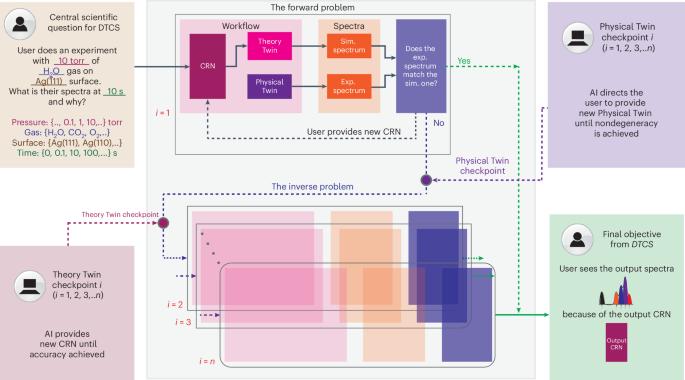Digital Twin for Chemical Science: a case study on water interactions on the Ag(111) surface
IF 18.3
Q1 COMPUTER SCIENCE, INTERDISCIPLINARY APPLICATIONS
引用次数: 0
Abstract
Directly visualizing chemical trajectories offers insights into catalysis, gas-phase reactions and photoinduced dynamics. Tracking the transformation of chemical species is best achieved by coupling theory and experiment. Here we developed Digital Twin for Chemical Science (DTCS) v.01, which integrates theory, experiment and their bidirectional feedback loops into a unified platform for chemical characterization. DTCS addresses a core question: given a set of experimental conditions, what is the expected outcome and why? It consists of a forward solver that takes a chemical reaction network and predicts spectra under experimental conditions, and an inverse solver that infers kinetics from measured spectra. We applied DTCS to ambient-pressure X-ray photoelectron spectroscopy measurements of the Ag–H2O interface as an example. This approach enables real-time knowledge extraction and guides experiments until a stopping condition is met based on accuracy and degeneracy. As a step toward autonomous chemical characterization, DTCS provides mechanistic knowledge in a verified, standardized manner. Interpreting spectroscopic data in real time remains a challenge in chemical characterization. Here a digital twin framework is developed that links first-principles theory and experimental data via a bidirectional feedback loop, enabling on-the-fly decision-making and insights into reaction mechanisms based on measured spectra during chemical experiments.

化学科学的数字孪生:Ag(111)表面水相互作用的案例研究。
直接可视化化学轨迹提供了对催化、气相反应和光诱导动力学的见解。通过理论与实验相结合的方法来跟踪化学物质的变化。在这里,我们开发了Digital Twin for Chemical Science (DTCS) v.01,它将理论、实验及其双向反馈回路集成到一个统一的化学表征平台中。DTCS解决了一个核心问题:给定一组实验条件,预期结果是什么?为什么?它包括一个采用化学反应网络并在实验条件下预测光谱的正向求解器和一个从测量光谱推断动力学的逆求解器。我们将DTCS应用于Ag-H2O界面的常压x射线光电子能谱测量作为一个例子。该方法能够实时提取知识,并根据准确性和简并度指导实验直到满足停止条件。作为迈向自主化学表征的一步,DTCS以经过验证的、标准化的方式提供了机理知识。
本文章由计算机程序翻译,如有差异,请以英文原文为准。
求助全文
约1分钟内获得全文
求助全文

 求助内容:
求助内容: 应助结果提醒方式:
应助结果提醒方式:


